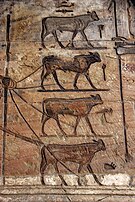This is an old revision of this page, as edited by Gloriamerrier (talk | contribs) at 15:17, 11 June 2009 (lnked refs to the article). The present address (URL) is a permanent link to this revision, which may differ significantly from the current revision.
Revision as of 15:17, 11 June 2009 by Gloriamerrier (talk | contribs) (lnked refs to the article)(diff) ← Previous revision | Latest revision (diff) | Newer revision → (diff)| This article is an orphan, as no other articles link to it. Please introduce links to this page from related articles; try the Find link tool for suggestions. (August 2008) |
| ||
| Charcoal block Flames on one end in hieroglyphs | ||
|---|---|---|
| ||
| Charcoal block Flames on one end approximated, but with flames in hieroglyphs | ||
|---|---|---|
The Ancient Egyptian Black (hieroglyph), has different forms, but with similar meanings related to the common color black; it has other meanings, elsewhere used by various addititive determinatives. (Budge two-volume dictionary has 27 entries using the hieroglyph, many referencing items of black; the first two entries deal with an item that 'burns out'-things that 'come to an end'.)
Ancient Egypt is commonly referred to as 'Kam-t' , with the theorized reference to the black Nile Delta earth. A more likely theorized reference is to the people. The determinative used is called the niw.t(a political designate). It is a circle with a cross which represents a city intersection. A literal translation of KM.t is "Black Land", "Black City" or "Black Nation"
Other word uses of "black" are also related to the, gloomy, or dark; there is a coptic language usage with additional word white, as also expressed in hieroglyphs, for "black and white".
Hieroglyphic definition of glyph-icon
The hieroglyph I6 is commonly explained as a piece of crocodile skin with spines.
Rosetta Stone: hieroglyph and Demotic "kmi"-"Egypt"

identified as "black".
| ||||||||||
| Egypt named "Baq-t" or "Kam-t" in hieroglyphs | ||||||||||
|---|---|---|---|---|---|---|---|---|---|---|
The 198 BC Rosetta Stone uses the Black (hieroglyph) three times to make the name of Egypt: Kam-t, or Kem-t. Of the 22 uses, 7 are for another name of egypt as Baq-t.
In the Demotic (Egyptian) text of the Rosetta Stone, the demotic for Egypt is 'Kmi' . There are three uses of the actual Kmi, but 6 others referenced as Kmi refer to Baq-t in the hieroglyphs; there is one actual 'Bki' in the Demotic text that is used in a pairing sentence, for emphasis: "... Baq-t... and... Kam-t."-(Rosetta Stone, line 6)
- Kmi—spelling-Egypt—(22 places, sychronized, Demotic–Hieroglyphs)
|
Literature
A magazine focussed on Ancient Egypt, its history, its iconography, and its modern day archaeological or linguistic work, is named for the name Kam-t-(Egypt). See Kmt (journal).
-
 A cow
A cow
identified as "black" -
 Nectanebo II obelisk, with various hieroglyphs including statement of erecting the obelisk-(to set-up: the Mast hieroglyph). (photo can be high-res expanded)
Nectanebo II obelisk, with various hieroglyphs including statement of erecting the obelisk-(to set-up: the Mast hieroglyph). (photo can be high-res expanded)
See also
- Kmt (journal)
- Kemeticism
- Kemet
- Mnewer, the black bull: "Black-Great (One)", Kemwer-(Km-ur)
- Gardiner's Sign List#Aa. Unclassified
External links
References
- An Egyptian Hieroglyphic Dictionary, (letter K, volume 2, pp 787-788)
- Gardiner 2005 (1957): 498
- Gardiner 2005 (1957): 475
- Budge. An Egyptian Hieroglyphic Dictionary, E.A.Wallace Budge, (Dover Publications), c 1978, (c 1920), Dover edition, 1978. (In two volumes) (softcover, ISBN 0-486-23615-3)
- Budge. A Hieroglyphic Dictionary to the Book of the Dead, E.A.Wallace Budge, Dover edition, 1991; Original: c 1911 as: A Hieroglyphic Vocabulary to the Theban Recension of the Book of the Dead with an Index to All the English Equivalents of the Egyptian Words, (Kegan Paul, etc. Ltd, London, publisher). Dover: (softcover, ISBN 0-486-23724-5)
- Budge. The Rosetta Stone, E.A.Wallace Budge, (Dover Publications), c 1929, Dover edition(unabridged), 1989. (softcover, ISBN 0-486-26163-8)